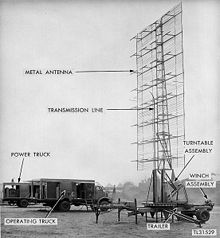 SCR-270: Similar to the model that detected the attacking Pearl Harbor planes (the actual Opana antenna was nine dipoles high by four wide, instead of the eight-by-four configuration shown here). The scale for reading the direction the antenna is pointing to can be seen at the base. | |
| Country of origin | United States |
|---|---|
| Introduced | 1940 |
| Type | 2D air-search |
| Frequency | 106 MHz |
| PRF | 621 Hz |
| Pulsewidth | 10 to 25 microseconds |
| RPM | 1 RPM |
| Range | 150 miles (240 km) |
| Diameter | 8 by 4 dipole array typical |
| Azimuth | 0–360° |
| Precision | 4 mi (6.4 km) 2°[1] |
| Power | 100 kW peak |
The SCR-270 was one of the first operational early-warning radars. It was the U.S. Army's primary long-distance radar throughout World War II and was deployed around the world. It is also known as the Pearl Harbor Radar, since it was an SCR-270 set that detected the incoming raid about 45 minutes before the December 7, 1941, attack on Pearl Harbor commenced.
Two versions were produced, the mobile SCR-270, and the fixed SCR-271 which used the same electronics but used an antenna with somewhat greater resolution. An upgraded version, the SCR-289, was also produced, but saw little use. The -270 versions were eventually replaced by newer microwave units based on cavity magnetron that was introduced to the US during the Tizard Mission. The only early warning system of the sort to see action in World War II was the AN/CPS-1, which was available in mid-1944, in time for D-Day.[2]
- ^ Wolff, Christian (n.d.). "SCR-270". Radartutorial. Archived from the original on 5 October 2022. Retrieved 24 January 2023.
- ^ AN/CPS-1 Microwave Early Warning (MEW) Radar, National Air and Space Museum
© MMXXIII Rich X Search. We shall prevail. All rights reserved. Rich X Search
